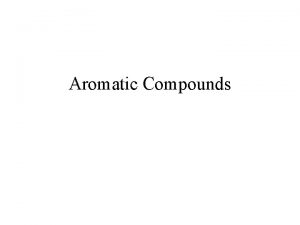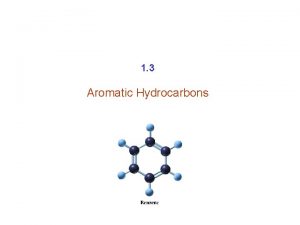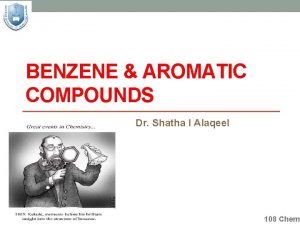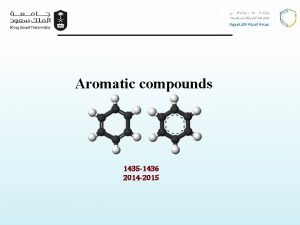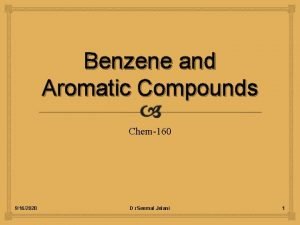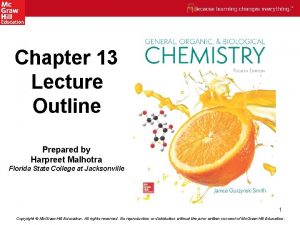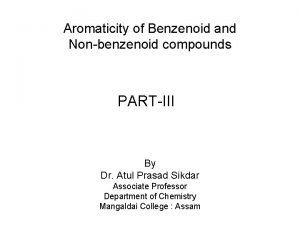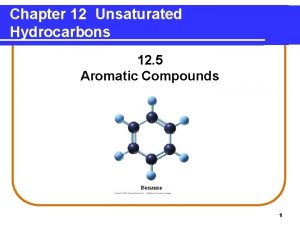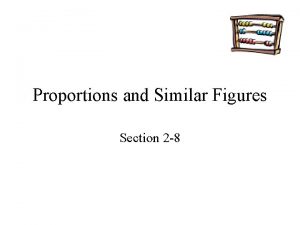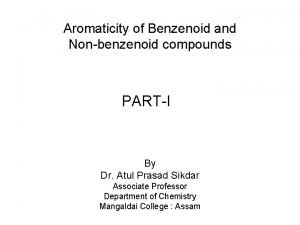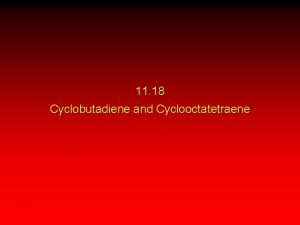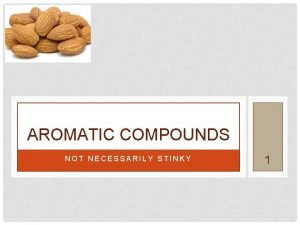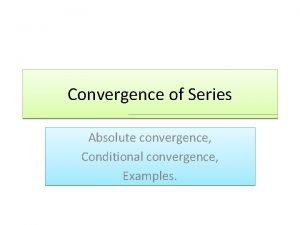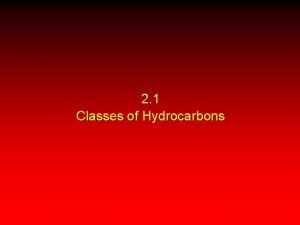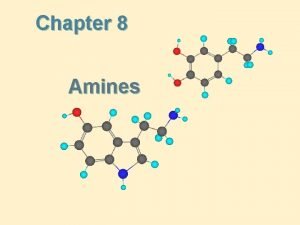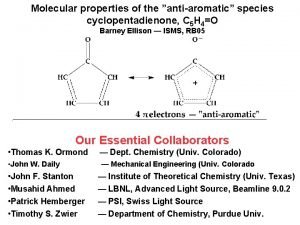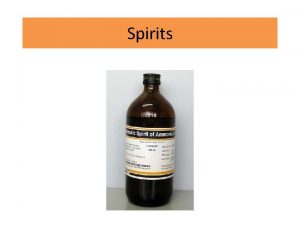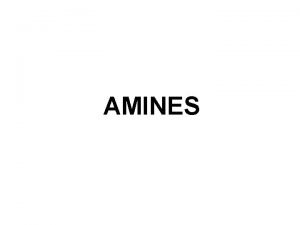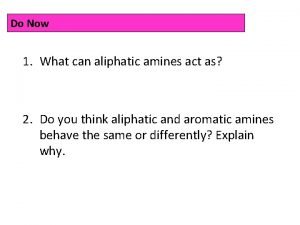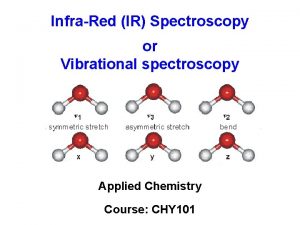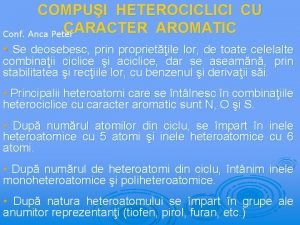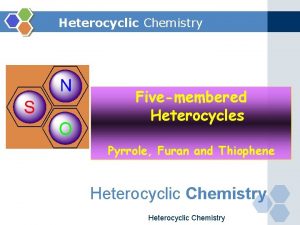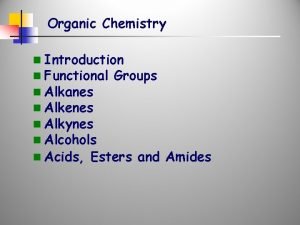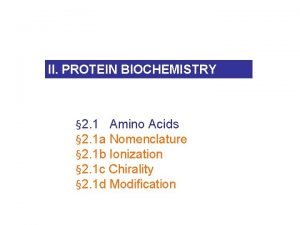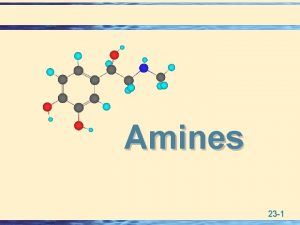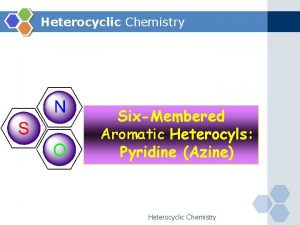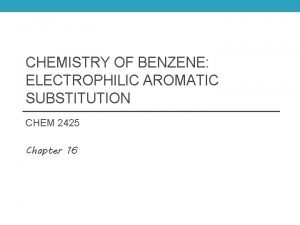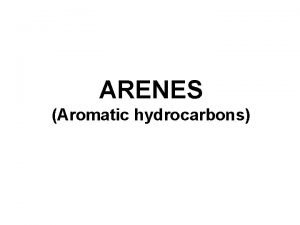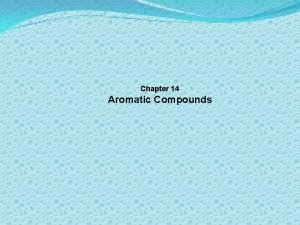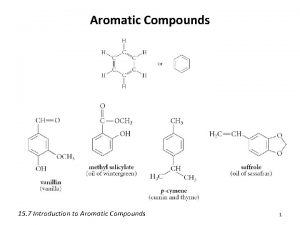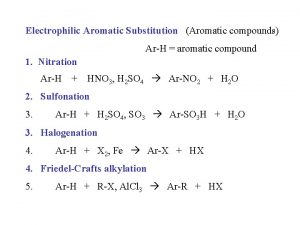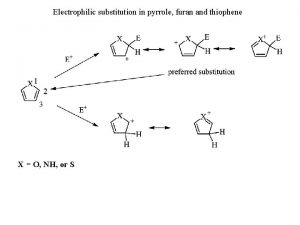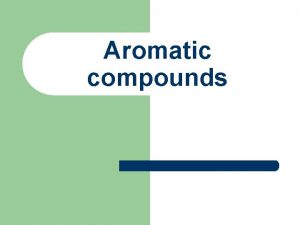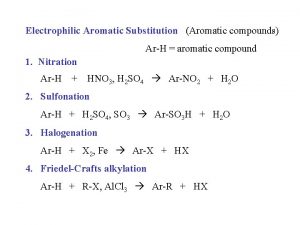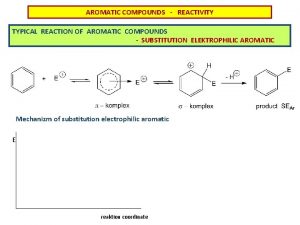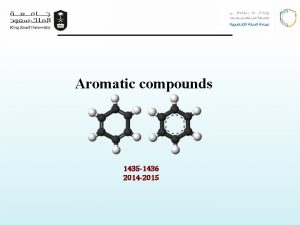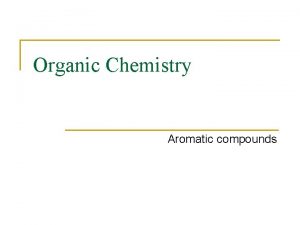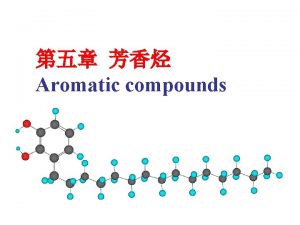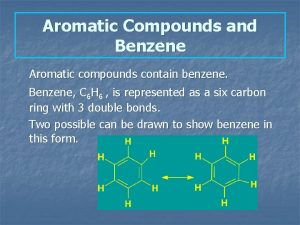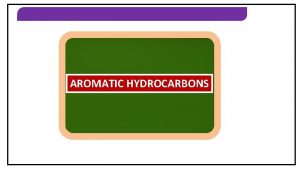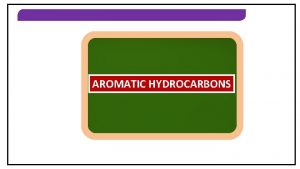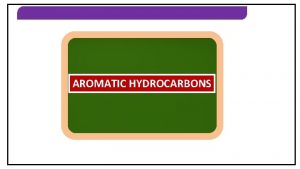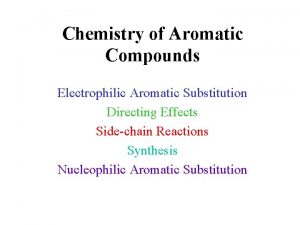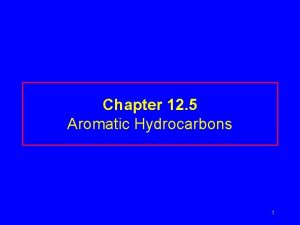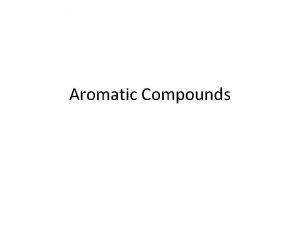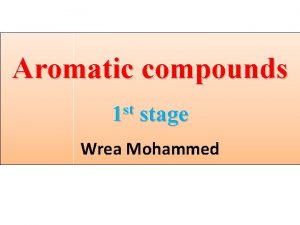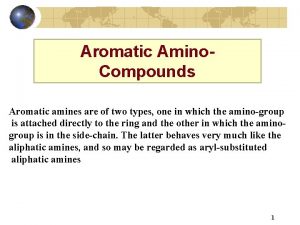AROMATIC COMPOUNDS NOT NECESSARILY STINKY 1 HISTORICAL SIGNIFICANCE













































- Slides: 45

AROMATIC COMPOUNDS NOT NECESSARILY STINKY 1

HISTORICAL SIGNIFICANCE • • Spices and herbs Desire to synthesize Deduced rather simple structure Common • Benzaldehyde • Benzyl alcohol • Toluene • Oxidation and further rxn yields the parent hydrocarbon • C 6 H 6 2

BENZENE FACTS • • First isolated by Michael Faraday in 1825 Parent HC of aromatic cpds Stable cpds Appears unsaturated • Br 2 added to it still appears brown unlike other unsaturated cpds • KMn. O 4 oxidation uncommon • Does not undergo typical addition rxns of alkenes • Substitution • Main rxn of benzene 3

BENZENE FACTS Fe. Br 3 C 6 H 6 + Br 2 C 6 H 5 Br + HBr benzene bromobenzene Fe. Cl 3 C 6 H 6 + Cl 2 C 6 H 5 Cl + HCl benzene chlorobenzene • No isomers are produced by either rxn • All six H’s must be chemically equivalent 4

BENZENE FACTS Fe. Br 3 C 6 H 5 Br + Br 2 C 6 H 4 Br 2 + HBr bromobenzene dibromobenzene • 3 isomers are produced by further addition of Br 2 • Same will occur with chlorobenzene • Must be explained by structure of benzene 5

KEKULÉ BENZENE STRUCTURE • 1865 Friedrich August Kekulé proposed reasonable structure • First to realize that C was tetravalent (needed 4 bonds) • Architect originally • Suggested conjugated structure of 6 C’s in hexagonal shape with 1 H on each C • To account for lack of positive tests for unsaturation, proposed that single and double bonds exchange positions rapidly 6

KEKULÉ BENZENE STRUCTURE Write the equation for the rxn of benzene and bromine using a Kekulé structure. 7

RESONANCE BENZENE MODEL • • Kekulé not entirely correct His structures differ only in arrangement of electrons Atoms occupy same positions This is resonance • No equilibrium arrows • Resonance double-headed arrow instead 8

RESONANCE BENZENE MODEL • No single or double bonds btw C’s in benzene • Planar • All C-C lengths are the same: 1. 39 Å • How does this compare to single and double lengths? • Compare to cyclohexane 9

ORBITAL MODEL OF BENZENE • All C’s are attached to only 3 other atoms • All C’s are sp 2 hybridized • 2 sp 2 of one C overlap with 2 similar of another C to make the bonds that form the hexagon • Other sp 2 overlaps with 1 s of each H • Perpendicular to each sp 2 plane, lay unhybridized p’s • Those p’s do a side-to-side bond… bond 10

ORBITAL MODEL OF BENZENE • Notice p orbitals do not lie in plane of bonded sp 2 and 1 s orbitals 11

SYMBOLS FOR BENZENE • Kekulé structure…keeps electrons clearly in mind • 2 delocalized representations • H’s not usually written in either 12

NOMENCLATURE OF AROMATICS • Preceded systematic nomenclature • Historic names are respected and accepted by IUPAC • Several important aromatics that need to be committed to memory 13

NOMENCLATURE OF AROMATICS benzene toluene cumene styrene phenol anisole benzaldehyde acetophenone benzoic acid aniline 14

NOMENCLATURE OF AROMATICS • Monosubstituted benzenes w/o common names accepted by IUPAC named with benzene as the root chain bromobenzene nitrobenzene ethylbenzene propylbenzene 15

NOMENCLATURE OF AROMATICS • When 2 substituents, 3 isomers are possible • 1, 2, ortho-, o • 1, 3, , meta, m • 1, 4, para, p- ortho-dichlorobenzene (o-dichlorobenzene) (1, 2 -dichlorobenzene) meta-dichlorobenzene (m-dichlorobenzene) (1, 3 -dichlorobenzene) para-dichlorobenzene (p-dichlorobenzene) (1, 4 -dichlorobenzene) 16

NOMENCLATURE OF AROMATICS • Benzene with 2 methyl groups is called xylene o-xylene p-xylene • When 2 substituents are not identical, o-, m-, p- are still used • Substituents are alphabetized where appropriate • With 3 substituents, normal IUPAC rules 17

NOMENCLATURE OF AROMATICS o-bromochlorobenzene m-nitrotoluene m-chlorophenol o-ethylaniline p-chlorostyrene 18

NOMENCLATURE OF AROMATICS • Aromatic HC’s known as arenes (Ar, aryl group) • Ar-R…arylalkane • Benzene can be a substituent • Known as phenyl group (Ph) • Another group worth noting • Known as benzyl group 19

NOMENCLATURE OF AROMATICS 2 -phenylpentane phenylcyclopropane 1, 3, 5 -triphenylbenzene (2 -pentylbenzene) (cyclopropylbenzene) biphenyl benzyl chloride m-nitrobenzyl alcohol 20

RESONANCE ENERGY OF BENZENE • Resonance hybrid more stable than any contributing structures…proven by benzene’s hybrid structure • Hydrogenation of C=C bond is exothermic and releases 109 -125 k. J/mol • C=C + H-H C-C + 109 -125 k. J • + H-H + 119. 5 k. J 21

RESONANCE ENERGY OF BENZENE • Two C=C bonds broken should release 2 x the amount of 1 bond • + 2 H-H + 239 k. J • Thus, three C=C bonds should release 3 x • + 3 H-H + 208 k. J • Benzene proves more difficult to hydrogenate, than simple alkenes 22

RESONANCE ENERGY OF BENZENE • Therefore, the resonance hybrid structure is more stable (by >150 k. J) than any contributing structure proposed by Kekulé • Difference in hypothesized energy and actual energy is known as resonance energy • Aromatic cpds tend to preserve their aromatic structures and thus preserve their resonance energy 23

ELECTROPHILIC AROMATIC SUBSTITUTION • Most common rxn • Replaces 1 H in the ring • Chlorination: • Nitration: • Sulfonation: Fe. Cl 3 + Cl 2 H 2 SO 4 + HNO 3 SO 3 + H 2 SO 4 + HCl + H 2 O 24

ELECTROPHILIC AROMATIC SUBSTITUTION • Alkylation: • Acylation: Al. Cl 3 + RCl + CH 2=CH 2 + + HCl H 2 SO 4 Al. Cl 3 + HCl 25

MECHANISM OF ELECTROPHILIC AROMATIC SUBSTITUTION • Most of the previously illustrated substitution rxns involve initial attack by an electrophile on the benzene ring • Consider the chlorination rxn Fe. Cl 3 + Cl 2 + HCl • Without the catalyst, the rxn occurs very slowly. • The catalyst acts as a Lewis acid, converting Cl 2 to a strong electrophile 26

MECHANISM OF ELECTROPHILIC AROMATIC SUBSTITUTION Cl—Cl weak electrophile + Cl Fe—Cl Cl∙∙∙∙∙Fe—Cl Cl strong electrophile + Cl—Cl∙∙∙∙∙Fe. Cl 3 + Fe. Cl 4 benzonium ion 27

MECHANISM OF ELECTROPHILIC AROMATIC SUBSTITUTION • Resulting carbocation is benzonium ion • Positive charge is delocalized by resonance in an ortho and para manner to the sp 3 hybridized C • Composite illustration of resonance hybrid of benzonium ion so…sp 3 C loses a proton Cl- + HCl 28

MECHANISM OF ELECTROPHILIC AROMATIC SUBSTITUTION • Generalizing this 2 -step mechanism yields: step 1 + E+ step 2 + H+ • In step 1, resonance energy is lost as pi bond is disrupted as electrophile attaches to a C in ring • In step 2, resonance energy is regained with loss of proton (H+) • Step 1 is slow since it requires so much energy (Ea), thus is ratedetermining step • Step 2 is fast with low Ea 29

MECHANISM OF HALOGENATION • Cl and Br easily react as seen • Halogen added slowly to mixture of aromatic cpd and Fe filings • Fe filings react with halogen to make catalyst, iron halide • F and I substitution are possible, but require other methods 30

MECHANISM OF NITRATION • Nitric acid is protonated by sulfuric acid • Protonated nitric acid loses water and makes nitronium ion, a very strong electrophile H+ nitric acid + protonated nitric acid nitronium ion 31

MECHANISM OF SULFONATION • Concentrated sulfuric acid catalyst • Strong electrophile is either sulfur trioxide, SO 3, or protonated sulfur trioxide, HSO 3+ • SO 3 is a strong electrophile at S SO 3 Na. OH H 2 SO 4 200°C benzenesulfonic acid phenol • Sulfonic acids are products; these are strong organic acids • If base is added, phenol is formed 32

MECHANISM OF ALKYLATION AND ACYLATION • Alkylation and acylation of benzene known as Friedel. Crafts rxns • In alkylation carbocation is electrophile • Formed by removing halide from alkyl halide with Lewis acid catalyst (i. e. Al. Cl 3) • Or formed by adding proton to an alkene • Cannot occur if benzene already has nitro or sulfonic acid group • In acylations acyl cation is electrophile • Generated from acid derivative, usually acyl halide • Makes aromatic ketones 33

MECHANISM OF ALKYLATION Cl Cl—Al Cl + Cl. CH 2 CH 3 Cl Cl—Al—Cl Cl + CH 2 CH 3 ethyl cation H+ CH 2=CH 2 CH 2 CH 3 ethyl cation 34

MECHANISM OF ALKYLATION + CH 2 CH 3 ethyl cation H+ ethylbenzene 35

MECHANISM OF ACYLATION O CH 3 CCl + Al. Cl 3 acetyl chloride + CH 3 C=O + Al. Cl 4 - acyl cation H+ acetophenone 36

RING-ACTIVATING VS RINGDEACTIVATING SUBSTITUENTS • Electron-seeking substituents increase rxn rate • Hydroxyl (-OH)…phenol • Methyl (-CH 3)…methylbenzene • Electron-withdrawing substituents decrease rxn rate • Chloro (--Cl)…chlorobenzene • Nitro (-NO 2)…nitrobenzene 37

ORTHO, PARA-DIRECTING VS METADIRECTING SUBSTITUENTS • Substituents already present on a ring determine the position taken by a new substituent • Some are ortho, para-directing • Amino, hydroxy, alkyl, halo • Some are meta-directing • Acyl, carboxyl, nitro • Important to know which it is due to desired products • Bromobenzene that is nitrated makes o- and pbromonitrobenzene • Nitrobenzene that is brominated makes m-bromonitrobenzene 38

POLYCYCLIC AROMATIC HYDROCARBONS • Aromaticity…unusual stability of certain fully conjugated cyclic systems…beyond benzene • Naphthalene, C 10 H 8, first pure cpd isolated from a byproduct of converting coal to coke 8 7 6 5 • • 8 a 4 a 1 2 3 4 C’s are numbered to indicate 3 sets of equivalent C’s BL’s are not all the same, but close to 1. 39 Å RE < 2 x that of benzene 251 k. J/mol Undergoes electrophilic substitution, with monosubstitution predominantly at C-1 39

NITRATION OF NAPHTHALENE AT C-1 • Four contributors are possible… • Draw the contributors for nitration at C-2. Why is C-1 preferred? 40

FUSED POLYCYCLIC HYDROCARBONS anthracene phenanthrene pyrene • PAH’s make up a large percentage of the C found in interstellar space • Observed in interstellar ice (Halley’s comet) • UV radiation of PAH’s in ice yield aromatic ketones, alcohols, and other cpds—prebiotic chemistry role? ! 41

42

43

44

45
 Stinky pete box template
Stinky pete box template Aromatic compounds huckel rule
Aromatic compounds huckel rule Benzene with oh group
Benzene with oh group Examples of non aromatic compounds
Examples of non aromatic compounds Non aromatic compounds
Non aromatic compounds Benzene bond length
Benzene bond length Aromatic compounds undergo
Aromatic compounds undergo Why is pyrrole aromatic
Why is pyrrole aromatic Unsaturated aromatic compounds
Unsaturated aromatic compounds 2-8 proportions and similar figures
2-8 proportions and similar figures Anything worth doing is not necessarily worth doing well
Anything worth doing is not necessarily worth doing well Similar
Similar What is n in huckel rule
What is n in huckel rule Cycloheptatriene cation is aromatic or not
Cycloheptatriene cation is aromatic or not Historical significance
Historical significance Banquo's ghost lesson
Banquo's ghost lesson What is the historical significance of this act?
What is the historical significance of this act? Benzonium ion
Benzonium ion What is historical significance
What is historical significance Historical background of hamlet
Historical background of hamlet Ionic metallic and covalent bonds venn diagram
Ionic metallic and covalent bonds venn diagram Absolute convergence implies convergence
Absolute convergence implies convergence Pqdn
Pqdn Sadlier unit 1 level d synonyms
Sadlier unit 1 level d synonyms Aliphatic vs aromatic
Aliphatic vs aromatic Aliphatic amines and aromatic amines
Aliphatic amines and aromatic amines Cyclopentadienone aromatic
Cyclopentadienone aromatic Hydroalcoholic solutions are spirit
Hydroalcoholic solutions are spirit Tertiary amine
Tertiary amine Amines chemsheets
Amines chemsheets Anharmonicity constant formula
Anharmonicity constant formula Caracter aromatic
Caracter aromatic Pyrazole synthesis slideshare
Pyrazole synthesis slideshare Cycloheptatrienyl cation
Cycloheptatrienyl cation Aromatic functional group
Aromatic functional group Protein ionization
Protein ionization Basicity amines
Basicity amines Pka of pyridine
Pka of pyridine Acylation of benzene
Acylation of benzene Aromatic hydrocarbons
Aromatic hydrocarbons P-bromonitrobenzene
P-bromonitrobenzene Classify the following molecule
Classify the following molecule Define medicinal plants
Define medicinal plants Which is aromatic
Which is aromatic Do aromatic amines give hinsberg test
Do aromatic amines give hinsberg test Furan nucleophilic substitution
Furan nucleophilic substitution

